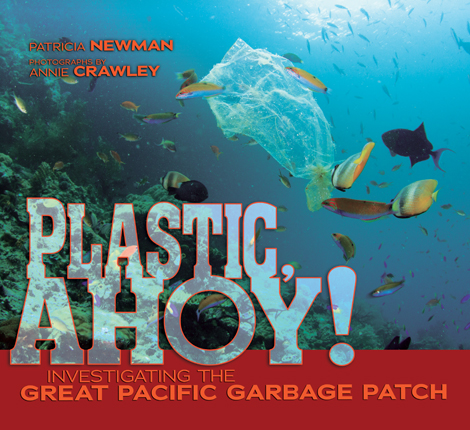Full Text Reviews: Booklist - 02/15/2014 Plastic has become a staple of material culture in the modern world, but few people give much thought to the countless pounds of waste they discard each day. Discovered in 1997, the Great Pacific Garbage Patch is a wide swath of postconsumer plastic waste that is found at the confluence of four major ocean currents in a vast area known as the North Pacific Central Gyre. This photojournalistic book follows three young female scientists living and working aboard a small research ship that was part of the Scripps Environmental Accumulation of Plastics Expedition. It details the researchers’ process of developing a hypothesis, collecting evidence, and designing experiments to learn more about the impact of the Garbage Patch on marine life. The book is replete with Crawley’s dynamic photos of both the scientists at work and the challenges of life aboard a tiny research boat. Newman successfully summarizes all of their complex research findings into straightforward and doable tips for minimizing environmental impact. An engaging and worthwhile read, this will surely make young readers think twice about their trash. - Copyright 2014 Booklist. School Library Journal - 04/01/2014 Gr 4–8—This intriguing book informs readers about the overconsumption of plastic with an even distribution of facts, progress, and helpful ways to reduce reliance on plastic. The Great Garbage Patch consists of debris from water sources that feed into the Pacific Ocean. Discovered in 1997, it was formed through millions, or perhaps billions, of plastic pieces. Through meeting three young people involved in the project, readers gain a personal connection to the project, which included three weeks of examining samples of plastic and ocean organisms to discover the effects of plastic on marine life. "Ocean Science" tidbits elaborate on scientists' research tools, marine life food chain, and survival of sea animals. The team's adjustment to ship life and descriptions of how they spent their free time, their sleeping quarters, and meals add enjoyable personal touches. Pictures and maps are clean, colorful, and annotated. Information boxes explore further scientific topics, such as how the crew applied the scientific method in order to frame their research. The balance between text, graphics, and photographs is ideal. Emphasis on scientists needing help from children and adults in order to solve the problem of plastics killing ocean life empowers readers, as do tips for reducing personal reliance on plastics. Source notes, glossary, and sources for further information are included. Recommended for all general collections needing an attractive and informative look at the environmental effect of plastics that encourages young readers to take meaningful and doable action.—Jennifer Schultz, Fauquier County Public Library, Warrenton, VA - Copyright 2014 Publishers Weekly, Library Journal and/or School Library Journal used with permission. Bulletin for the Center... - 06/01/2014 In 2009 three graduate students boarded the New Horizon with the Scripps Environmental Accumulation of Plastic Expedition to study the now infamous garbage-riddled gyre in the Pacific Ocean. Each student had a particular mission. Miriam wanted to know whether the marine insect Halobates, which thrives while drifting around on plastic bits, deprives other organisms of food. Darcy focused on the relative populations of phytoplankton near the shore and in the gyre. Chelsea, a chemist, gathered information on leeching and absorption of chemicals as the plastic breaks down at sea. The spotlight on how these three scientists-in-training go about constructing their experiments and gathering data is similar to that of the Scientists in the Field series, only pitched here for a slightly younger audience. This title lacks the allure of the rubber ducky and sneaker flotsam (not to mention the effervescent personality of its oceanographer subject) in Loree Griffin Burns’ Tracking Trash (BCCB 5/07), but Newman does a solid job of walking readers through the trio of studies in an orderly fashion, and plenty of color photographs convey a sense of ship life for readers more drawn to the adventure than the science. Too much truly useful information is tucked into sidebars and lengthy picture captions, though, forcing readers into a dilemma of whether to lose the narrative flow to catch the background, or stick with the story and backtrack later for the missing pieces. Source notes and an index are included, as well as a handful of books and a brief but well selected list of websites for further research. EB - Copyright 2014 The Board of Trustees of the University of Illinois. Loading...
|



